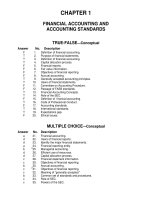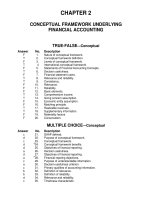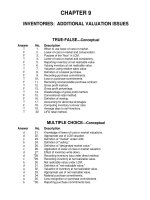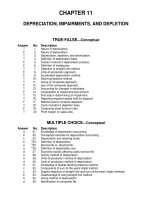Intermediate accounting 16e by kieso slide ch06
Bạn đang xem bản rút gọn của tài liệu. Xem và tải ngay bản đầy đủ của tài liệu tại đây (2.56 MB, 90 trang )
6-1
PREVIEW OF CHAPTER 6
6-2
Intermediate Accounting
16th Edition
Kieso ● Weygandt ● Warfield
6
Accounting and the Time
Value of Money
LEARNING OBJECTIVES
After studying this chapter, you should be able to:
1 Describe the fundamental
concepts related to the time
value of money.
2 Solve future and present value of
1 problems.
4 Solve present value of ordinary
and annuity due problems.
5 Solve present value problems
related to deferred annuities,
bonds, and expected cash flows.
3 Solve future value of ordinary
and annuity due problems.
6-3
LO 1
BASIC TIME VALUE CONCEPTS
Time Value of Money
A relationship between time and money.
A dollar received today is worth more than a dollar
promised at some time in the future.
When
When deciding
deciding among
among investment
investment or
or
borrowing
borrowing alternatives,
alternatives, itit is
is essential
essential to
to be
be
able
able to
to compare
compare today’s
today’s dollar
dollar and
and
tomorrow’s
tomorrow’s dollar
dollar on
on the
the same
same footing—to
footing—to
“compare
“compare apples
apples to
to apples.”
apples.”
6-4
LO 1
Applications of Time Value Concepts
Present Value-Based Accounting
Measurements
1. Notes
2. Leases
3. Pensions and Other
Postretirement
Benefits
5. Shared-Based
Compensation
6. Business Combinations
7. Disclosures
8. Environmental Liabilities
4. Long-Term Assets
6-5
LO 1
BASIC TIME VALUE CONCEPTS
The Nature of Interest
6-6
Payment for the use of money.
Excess cash received or repaid over the amount lent
or borrowed (principal).
LO 1
BASIC TIME VALUE CONCEPTS
Simple Interest
Interest computed on the principal only.
Illustration: Barstow Electric Inc. borrows $10,000 for 3 years
at a simple interest rate of 8% per year. Compute the total
interest to be paid for the 1 year.
Interest = p x i x n
Annual
Interest
= $10,000 x .08 x 1
= $800
Federal law requires the disclosure of interest rates on an annual basis.
6-7
LO 1
BASIC TIME VALUE CONCEPTS
Simple Interest
Interest computed on the principal only.
Illustration: Barstow Electric Inc. borrows $10,000 for 3 years
at a simple interest rate of 8% per year. Compute the total
interest to be paid for the 3 years.
Interest = p x i x n
Total
Interest
= $10,000 x .08 x 3
= $2,400
6-8
LO 1
BASIC TIME VALUE CONCEPTS
Simple Interest
Interest computed on the principal only.
Illustration: If Barstow borrows $10,000 for 3 months at a 8%
per year, the interest is computed as follows.
Partial
Year
Interest = p x i x n
= $10,000 x .08 x 3/12
= $200
6-9
LO 1
BASIC TIME VALUE CONCEPTS
Compound Interest
6-10
Computes interest on
►
principal and
►
interest earned that has not been paid or withdrawn.
Typical interest computation applied in business
situations.
LO 1
Compound Interest
Illustration: Tomalczyk Company deposits $10,000 in the Last National
Bank, where it will earn simple interest of 9% per year. It deposits another
$10,000 in the First State Bank, where it will earn compound interest of
9% per year compounded annually. In both cases, Tomalczyk will not
withdraw any interest until 3 years from the date of deposit.
Year 1 $10,000.00 x 9%
$ 900.00
$ 10,900.00
Year 2 $10,900.00 x 9%
$ 981.00
$ 11,881.00
Year 3 $11,881.00 x 9%
ILLUSTRATION 6-1
Simple vs. Compound Interest
6-11
$1,069.29 $ 12,950.29
LO 1
WHAT DO THE NUMBERS MEAN?
A PRETTY
GOOD START
WHAT’S
YOUR PRINCIPLE
The continuing debate on Social Security reform provides a great context to
illustrate the power of compounding. One proposed idea is for the government
to give $1,000 to every citizen at birth. This gift would be deposited in an
account that would earn interest tax-free until the citizen retires. Assuming the
account earns a modest 5% annual return until retirement at age 65, the
$1,000 would grow to $23,839. With monthly compounding, the $1,000
deposited at birth would grow to $25,617.
Why start so early? If the government waited until age 18 to deposit the money,
it would grow to only $9,906 with annual compounding. That is, reducing the
time invested by a third results in more than a 50% reduction in retirement
money. This example illustrates the importance of starting early when the
power of compounding is involved.
6-12
LO 1
BASIC TIME VALUE CONCEPTS
Compound Interest Tables
Table 6-1 - Future Value of 1
Table 6-2 - Present Value of 1
Table 6-3 - Future Value of an Ordinary Annuity of 1
Table 6-4 - Present Value of an Ordinary Annuity of 1
Table 6-5 - Present Value of an Annuity Due of 1
Number of Periods = number of years x the number of compounding
periods per year.
Compounding Period Interest Rate = annual rate divided by the
number of compounding periods per year.
6-13
LO 1
BASIC TIME VALUE CONCEPTS
Compound Interest Tables
ILLUSTRATION 6-2
Excerpt from Table 6-1
FUTURE VALUE OF 1 AT COMPOUND INTEREST
(Excerpt From Table 6-1, Page 1
How much principal plus interest a dollar accumulates to at the end of
each of five periods, at three different rates of compound interest.
6-14
LO 1
BASIC TIME VALUE CONCEPTS
Compound Interest Tables
Formula to determine the future value factor (FVF) for 1:
Where:
FVFn,i = future value factor for n periods at i interest
n
i
6-15
= number of periods
= rate of interest for a single period
LO 1
BASIC TIME VALUE CONCEPTS
Compound Interest Tables
Determine the number of periods by multiplying the number
of years involved by the number of compounding periods
per year.
ILLUSTRATION 6-4
Frequency of Compounding
6-16
LO 1
BASIC TIME VALUE CONCEPTS
Compound Interest Tables
A 9% annual interest compounded daily provides a 9.42%
yield.
Effective Yield for a $10,000 investment.
6-17
ILLUSTRATION 6-5
Comparison of Different
Compounding Periods
LO 1
BASIC TIME VALUE CONCEPTS
Fundamental Variables
Rate of Interest
Future Value
Number of Time Periods
Present Value
ILLUSTRATION 6-6
Basic Time Diagram
6-18
LO 1
6
Accounting and the Time
Value of Money
LEARNING OBJECTIVES
After studying this chapter, you should be able to:
1 Describe the fundamental
concepts related to the time
value of money.
2 Solve future and present value
of 1 problems.
4 Solve present value of ordinary
and annuity due problems.
5 Solve present value problems
related to deferred annuities,
bonds, and expected cash flows.
3 Solve future value of ordinary
and annuity due problems.
6-19
LO 2
SINGLE-SUM PROBLEMS
Two Categories
Unknown Present Value
Unknown Future Value
ILLUSTRATION 6-6
Basic Time Diagram
6-20
LO 2
SINGLE-SUM PROBLEMS
Future Value of a Single Sum
Value at a future date of a given amount invested, assuming
compound interest.
Where:
FV = future value
PV = present value (principal or single sum)
FVF n,i = future value factor for n periods at i interest
6-21
LO 2
Future Value of a Single Sum
Illustration: Bruegger Co. wants to determine the future value
of $50,000 invested for 5 years compounded annually at an
interest rate of 6%.
= $66,912
ILLUSTRATION 6-7
Future Value Time Diagram (n = 5, i = 6%)
6-22
LO 2
Future Value of a Single Sum
Alternate
Calculation
Illustration: Bruegger Co. wants to determine the future value
of $50,000 invested for 5 years compounded annually at an
interest rate of 6%.
What table
do we use?
ILLUSTRATION 6-7
Future Value Time Diagram (n = 5, i = 6%)
6-23
LO 2
Future Value of a Single Sum
Alternate
Calculation
i=6%
n=5
What factor do we use?
$50,000
Present Value
6-24
x
1.33823
Factor
=
$66,912
Future Value
LO 2
Future Value of a Single Sum
Illustration: Assume that Commonwealth Edison Company
deposited $250 million in an escrow account with Northern
Trust Company at the beginning of 2017 as a commitment
toward a power plant to be completed December 31, 2020. How
much will the company have on deposit at the end of 4 years if
interest is 10%, compounded semiannually?
Present Value
$250,000,000
0
1
Future Value?
2
3
4
5
6
What table do we use?
6-25
LO 2









